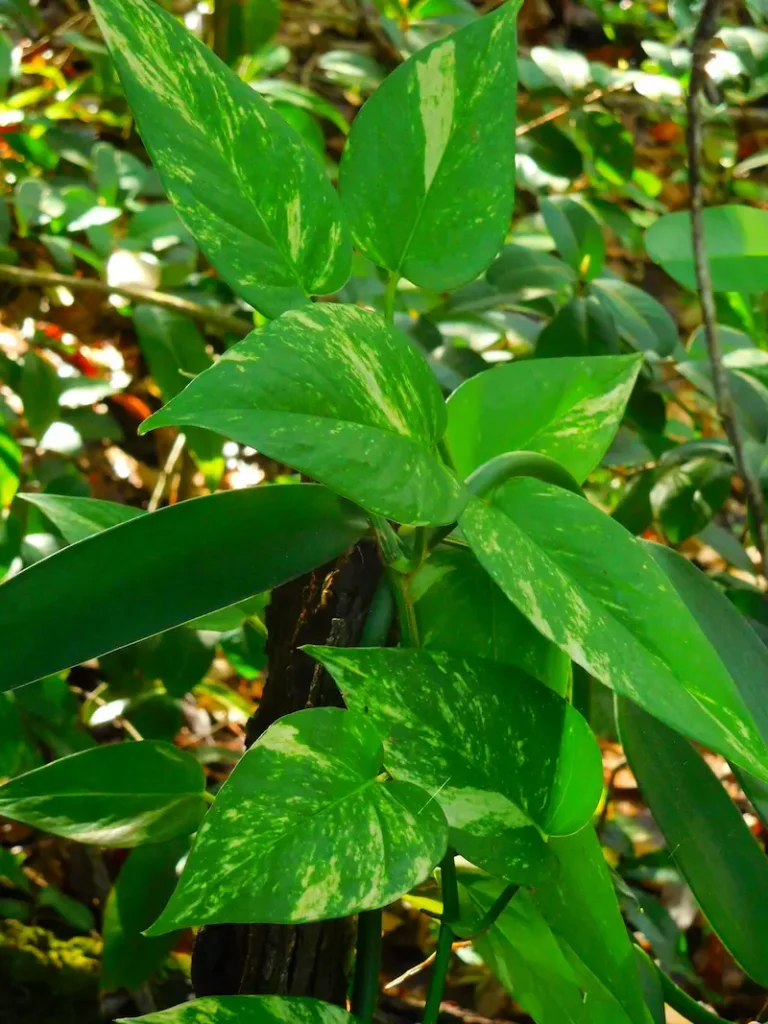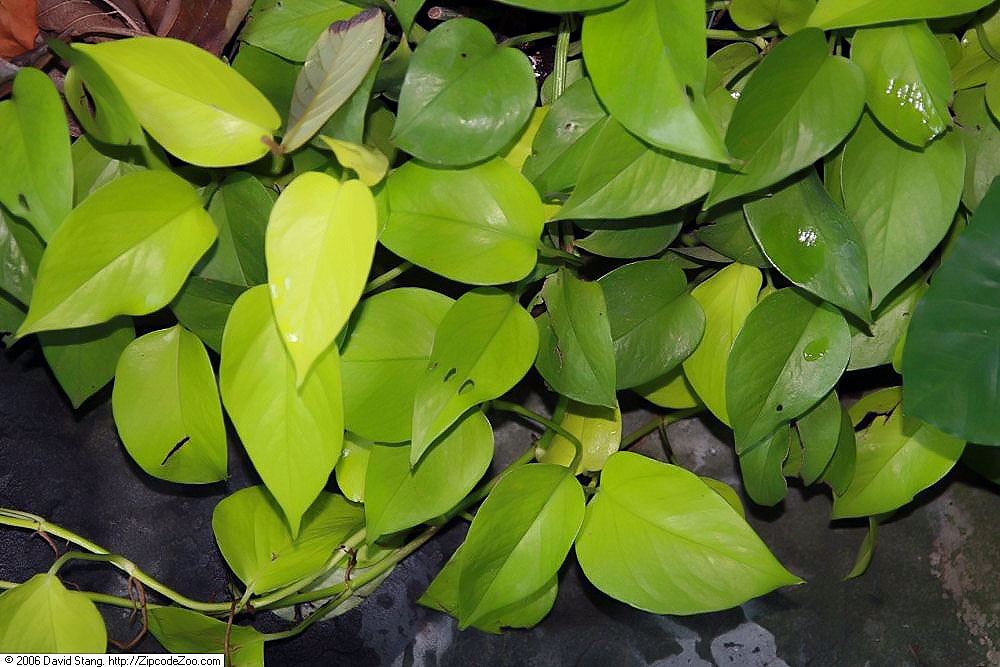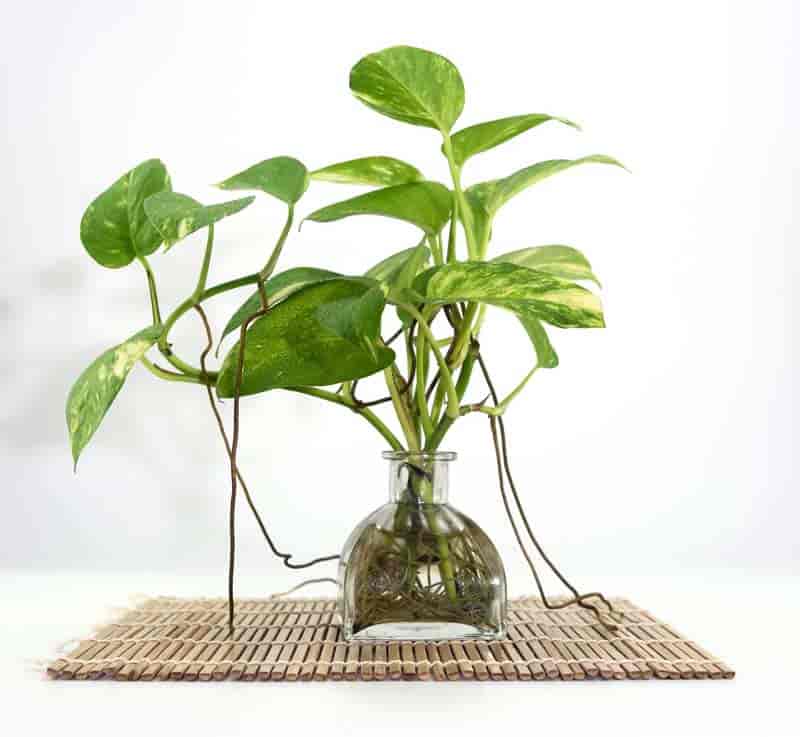Easy Care Pothos Plant

Pothos, Epipremnum aureum, has several great benefits, including being one of the best indoor plants for clean air and being a low-maintenance, multipurpose plant. Pothos requires just simple plant care instructions. They may be seen growing in small pots, hanging baskets, totems, and even as the only green they see all day – a vine hanging in their workplace cubicle. The Pothos – Jade Pothos, Golden Pothos, Neon and Marble Queen Pothos – are the houseplant leaders.
Types of Pothos
Pothos, botanical name is Epipremnum aureum, comes to the indoor houseplant world from Southeast Asia and the jungles of Malaysia. There are 15 types of Epipremnum aureum, and a few additional plants commonly referred to as pothos. The most popular Epipremnum aureum are Golden Pothos, Jade Pothos, Marble Queen Pothos, and Neon Pothos.
Quick Growing Guide
Botanical Name: Epipremnum aureum
Also Called: Devil’s ivy, silver vine, marble queen, taro vine, golden pothos
En français: Pothos
Sun / Shade:
Water: Tolerates minimal watering
Soil:
Care:
Golden Pothos

Pothos Gold, also known as Golden Pothos, grows through trailing stems as it climbs up trees and totem poles. The trailing stems’ heart-shaped leaves are glossy and dark green in hue, with yellow streaks. This growth behaviour makes the plant ideal for hanging baskets and moss-covered poles. Golden Pothos and Pothos Gold are believed to be efficient in removing indoor air pollutants.
Marble Queen Pothos

For a variety of reasons, the Marble Queen Pothos is a great and intriguing plant!
It is not only a gorgeous plant with exquisite variegation and colours, but it is also a highly adaptive and difficult to kill plant. Highly recommended.
Jade Pothos
Jade pothos is also known as a money plant or a good luck plant since it has long been connected with riches in Asian cultures. The Jade Pothos plant is well-known for its striking jade green foliage and its ability to bring a splash of colour to any space.
Neon Pothos

The name “Neon” was inspired by the brilliant lime or chartreuse green colours of the plant leaves, which seem virtually neon. Neon Pothos is a trailing vining plant that can reach a height of 2 feet. Its moderate growth rate, along with its beautiful creeping branches, makes it an excellent choice for hanging baskets. Neon Pothos is a wonderful present due to its simplicity and eye-catching foliage. Maintain an appealing Neon in a room with a reasonable temperature and bright light.
Pothos Light Needs
The most important factor in the success of the pothos plant is light, and it is best to use natural yet brilliant indirect light. Pothos leaves should not be exposed to direct sunlight; they lose their rich, luxuriant colour when exposed to bright sunlight, turning a pale green. A northern exposure with sunlight penetrating via completely opened blinds may be advantageous to the plant. If grow lights are the sole choice, 12-14 hours of light each day should be plenty to keep the pothos healthy. The lack of light causes new growth to be smaller, thinner, and weaker, as well as new leaves to “shrink.” It may take months of low light levels to notice the impact of this transformation.
How to Water Pothos
Check the pothos soil moisture like you would any other plant. Water the plant when the top inch of soil appears dry. Make sure to water the entire rootball, not just the top. Understand that the root system of Pothos is small in comparison to other indoor plants. As a result, saturate the whole soil mass and drain or throw away any excess water. When possible, use distilled or rainfall water; filtered water is a close second.
How often you water will depend on conditions, including light, ambient humidity, pot size, plant health, temperature, soil conditions and the season. Water more often in the summer to compensate for water loss through evaporation.
Recognize the signs of underwatering. The leaves will begin to wilt, and the older leaves often turn a bright yellow. This is why it’s important to thoroughly water the entire rootball.
When the plant is over watered, and the soil stays wet, the roots will rot. In turn, the leaves begin to wilt, and the leaves lose their healthy look turning to a pale dull green color.
Pothos and Temperature
Remember the Pothos comes from Malaysia. They like the same temperatures you do – 65 to 85 degrees Fahrenheit is best for steady growth.
Fertilizing
I’m not a big fan of using fertilizer on indoor plants. Most houseplants purchased in a good soil with all the needed nutrients sitting in the soil and should hold the plant for a long time.
In the case of plants planted in a poor soil mix the Pothos responds well to very light doses of fertilizer. If I had to fertilize – for homeowners – I would recommend a liquid type like Miracle-gro plant food instead of a solid or granular.
How to Propagate Pothos
- Begin by cutting 4-6 inch (10-15 cm) pieces of a healthy stem, ensuring that each cutting includes three or more leaves. Taking a diagonal cut is best.
- Remove the leaf closest to the cut.
- Place the cutting in a water-filled glass jar in a position with bright but indirect light.
- When the roots start to develop, place the cutting in a good soil
- Alternatively, dip the cutting in rooting hormone and place in good potting soil, including peat moss. Keep the soil moist. Again, placing it in bright but indirect sunlight.
- With both methods, the root takes about a month to develop.
Uses and Plant Size
Epipremnum aureum can be grown and used in a variety of ways and locations. Inside or outside doesn’t matter, Good filtered light, 65-85 degrees and a well-drained soil like this that holds moisture (not wet) and the plant will thrive. I’ve seen Pothos used as:
- Potted plant – small
- Hanging baskets
- Ground covers indoors and out
- Totem
- Covering the base of a larger plant
- Stand alone specimen – Like at Disneyworld
When Pothos receive “good growing conditions” as described above they can grow all year, For those of you up north with Pothos, you may notice a slow down during the winter months.
One true advantage the Pothos offers – they’re easy to find, and it’s a great plant to get started with and learn how to care for indoor houseplants.
You may also like the easy care Peperomia plant also known as the Radiator Plant
Versatility Makes Golden Pothos A #1 Houseplant
Question: What is the #1 indoor plant? The Spathiphyllium plant – or Corn Plant – Palms? Megan, Hope, Arkansas
Answer: I have to vote for the – Epipremnum aureum – commonly known as pothos. The pothos comes in a few different flavors:
Why is it the NUMERO UNO? – Versatility! Pothos plants are popular indoors because they are easy to grow and survives under the care of someone who has no green thumb.
It can be used as:
- Single stand-alone potted plant on a desk, credenza or even as a good bathroom plant
- Planted in mass as a ground cover
- Grown up a totem pole as an upright plant
- Hanging basket
- Planted with other plants in small gardens
- Covering on large trees or palm trunks
- Underplanting “garnish” for large potted plants or trees

Not only does the pothos have many uses but pothos can handle a wide variety of indoor conditions that rival some of the best indoor plants.
Conditions like cooler temperatures, lower humidity, and lower light levels. In south Florida you’ll even find the pothos growing in full sun.
Over the course of the year the average professional plantscaper uses more pothos than any other indoor plant.
Conditions for Success with Pothos
Epipremnum aureum does have some conditions that must be monitored for success. The number one area to watch is the root system. Pothos doesn’t like wet feet.
The pothos does not have a deep root system and can very easily be kept with too much water in the soil. Under lower light levels and cooler temperatures the soil should be allowed to dry about half way down. Try not to soak the soil but water lightly around the entire pot.
Pothos are grown from leaf-eye cuttings. Especially with the golden pothos growers try to select cuttings from plants that have a high marbling of yellow and green. The higher the light the brighter the yellows.
The average 6 or 8 inch pot can have 15 to 35 cuttings, with each one producing a new plant. With that many plants making up one pot you can see how important it is to not over water these plants.
If you find plants that are “underrooted”, make sure that the pot does not sit in water. Drain the excess water off. Keep the plant on the dry side.
Before you buy a pothos, pop it out of the pot, and look at the roots. You should see a healthy root system that looks full and active.
Over-watered pothos plants have mushy roots and rotted stems which pull out of the pot easily.
Recommended Reading: Another Tough Houseplant The Snake Plant – Sansevieria trifasciata
Pruning Pothos
Trim your pothos plants as they grow throughout the course of the year. Pruning encourages fresh growth and helps the plant fill out. To get the look you want for your plant, prune a selection of vines. Prune a vine immediately above the point at which a leaf connects to it. The number of vines you cut depends on the aesthetic you want. If you choose, you can even trim the vine to as little as 2 inches from the soil line, but always leave a few leaves on the vine.
You can start a new plant with these cuttings, place the cuttings in a different pot and keep the pot small. See the Propagation section above.
Pothos and Pests
The most common pest on pothos is root mealy bugs or those hiding in leaf axils. It’s that cotton like stuff you see normally on the undersides of the leaves. You can:
- Try to remove them manually
- Use alcohol and a cotton swab
- Apply some of the insecticidal soaps
The keys to success in growing pothos the #1 indoor plant is simple. Look for a plant that is well rooted, free of any insects or disease and easy on the water.
Is Pothos Toxic to Cats and Dogs?
Technically, pothos is not toxic. It is not poisonous in the sense that it will not harm your cat or dog’s kidneys. However, your cat or dog should not be chewing on pothos leaves or stems. They contain a form of mineral known as calcium oxalate crystals. These minerals, unlike most others, are not easily absorbed. Instead, they can puncture the delicate tissues, including those in the mouth, throat, and stomach.
